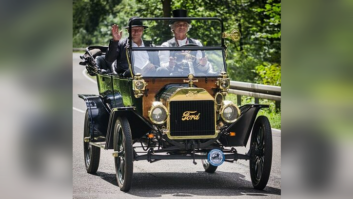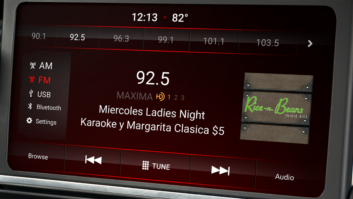IBOC and data
Aug 1, 2005 12:00 PM, By Kevin McNamara, CNE
In the April issue of Radio magazine, I wrote about the real return on investment of IBOC. While researching for that article, it became abundantly clear that the real return of migrating to IBOC comes down to the simple fact that it levels the playing field. How? By allowing the radio broadcast to position itself against the myriad of new digital-based program delivery technologies that are aching to gain a little share of the radio audience. There have been several well-known studies telling us that these new media, including webcasting, podcasting, cellcasting and yes, even satellite radio, will take an increasing piece of the revenues terrestrial broadcasters have enjoyed. In my article, I theorized that the incorporation of an easily accessible universal data port in each receiver would be essential for broadcasters to take full advantage of any potential revenue opportunity from data streaming over their carriers.
Protocols; a review
Having said this, we are all well aware of the bandwidth capabilities that IBOC will provide using the various data modes, hybrid, extended hybrid and all-digital, but ultimately it is the job of the protocol that defines its ability for data to work in the real world. Protocols contribute to the ultimate framework that efficiently gets the data from source to destination, with as few errors as possible. They define the rules that permit different devices to communicate.
In the world of data there are two basic categories of protocols: low- and high-level. Low-level protocols deal with the physical and electrical standards of interfacing the data to a device, i.e. the primary job of the network interface. High-level protocols address the data formatting, syntax and other aspects of the encoded message.

First-generation data capabilities
The current data capabilities of IBOC are still somewhat limited in terms of what can be broadcast. This is not necessarily a limitation of the IBOC technology, but what, in my opinion, the receiver manufacturers feel are the critical features needed to sell radios and the lack of a standard in place to define the next generation of data services.
IBOC currently supports a standard called ID3V2, which is simply an implementation of tagging MP3 and other types of audio and video file formats, to provide specific information about the file. Tagging involves appending a frame of information, also called a chunk, at the beginning of the binary audio (or video) file. This is essentially the same as the Cart Chunk standard that was talked about for several years. In short, this is the method that IBOC uses to encode and decode textual program related information such as the song name, artist and about 40 additional fields of predefined information.
In the future, IBOC will support the Synchronized Multimedia Integration Language (SMIL), which is a method to deliver rich content-based multimedia programming using a variety of audio, video, text and other media.
Perhaps the most exciting proposal for IBOC is the Advanced Application Services (AAS) framework. AAS will provide specific Application Programming Interfaces (API), which would create a development platform to enable programmers to develop a wide range of future applications. A white paper by Thom Linden entitled An Advanced Application Services Framework for Application and Service Developers using HD Radio Technology (available on the Ibiquity website at www.ibiquity.com) discusses the proposal and gives some good applications. Of particular interest is an application where it would be possible to create a distributed network across multiple stations, where any one station could originate programming. In a past article I wrote about the possibility of combining (programming) multiple local facilities into a regional network using a common data stream.
Consider a group of HD Radio-enabled stations that individually provide a usable signal from Washington, DC, to Boston. Also assume that a proper distribution network was created and available at each of these stations. Finally, we encode the digital program material with a chunk that identifies each station in the group as a common entity. In this example, it might be possible to program a user’s radio to automatically switch frequency based on what they are currently tuned to as they travel throughout the area.

The Radiosophy Multistream includes a USB port to update the radio”s firmware. Data ports on future HD Radio receivers may provide a baseband data output.
While it is somewhat similar to the RBDS function of following a particular format, the IBOC implementation would allow a listener to follow all stations owned by particular operators within that region, thus preserving the revenue stream.
What about the hardware?
The current generation of semiconductor technologies, aimed directly at the digital radio market, provide flexibility in their ability to handle existing and future data applications as a result of the use of programmable digital signal processors (DSP). These classes of semiconductors can provide virtually all of the RF, baseband and signal processing capability within a single package and the firmware can be updated as necessary.
Recently, receiver manufacturer Radiosophy added a USB port on its programmable radio, however in this case the port was used to provide software upgrades via the Internet and permitted stations to program preset buttons with a logo into the radio. While it appears the port is not currently able to provide baseband IBOC data to external devices, it is a still unique application for the programmable DSP-based radio.
Conclusion
As a medium, IBOC appears to be pulled in various directions: digital audio with data channels, supplemental audio channels (to provide multiple audio channels) and surround sound. Most of these discussions are still in process with no clear direction where the future of IBOC will go. However, what is certain is that stations are assigned a limited bandwidth and trade-offs will need to be made, most likely at the expense of potential ancillary data channels.
Recent press seems to indicate owners and operators have a growing interest in multiple audio channels, while it doesn’t seem like there is a great deal of interest in exploiting opportunities using the ancillary data capacity. As much as I believe the utilization of the data channels would be essential to competing with other more widespread media outlets, I have to step back into reality and remember radio was only intended to be a local outlet and, realistically, who wouldn’t want twice the quality programming and commercial content the local guy brings us instead of all that uninterrupted music we’re getting with the real digital broadcasters?
McNamara is president of Applied Wireless, Elkins Park, PA.







